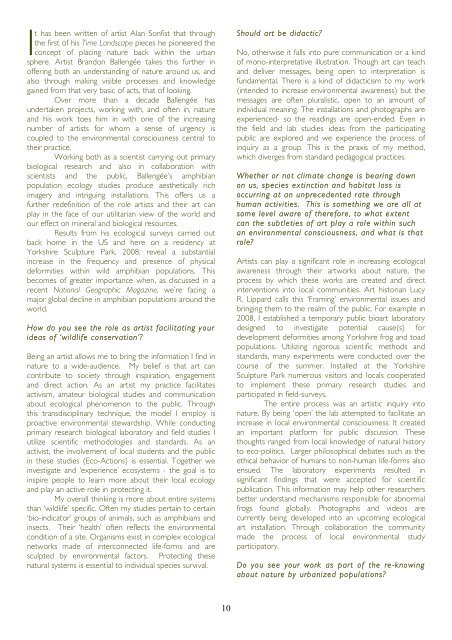M - Antennae The Journal of Nature in Visual Culture
M - Antennae The Journal of Nature in Visual Culture
M - Antennae The Journal of Nature in Visual Culture
Create successful ePaper yourself
Turn your PDF publications into a flip-book with our unique Google optimized e-Paper software.
I<br />
t has been written <strong>of</strong> artist Alan Sonfist that through<br />
the first <strong>of</strong> his Time Landscape pieces he pioneered the<br />
concept <strong>of</strong> plac<strong>in</strong>g nature back with<strong>in</strong> the urban<br />
sphere. Artist Brandon Ballengée takes this further <strong>in</strong><br />
<strong>of</strong>fer<strong>in</strong>g both an understand<strong>in</strong>g <strong>of</strong> nature around us, and<br />
also through mak<strong>in</strong>g visible processes and knowledge<br />
ga<strong>in</strong>ed from that very basic <strong>of</strong> acts, that <strong>of</strong> look<strong>in</strong>g.<br />
Over more than a decade Ballengée has<br />
undertaken projects, work<strong>in</strong>g with, and <strong>of</strong>ten <strong>in</strong>, nature<br />
and his work toes him <strong>in</strong> with one <strong>of</strong> the <strong>in</strong>creas<strong>in</strong>g<br />
number <strong>of</strong> artists for whom a sense <strong>of</strong> urgency is<br />
coupled to the environmental consciousness central to<br />
their practice.<br />
Work<strong>in</strong>g both as a scientist carry<strong>in</strong>g out primary<br />
biological research and also <strong>in</strong> collaboration with<br />
scientists and the public, Ballengée’s amphibian<br />
population ecology studies produce aesthetically rich<br />
imagery and <strong>in</strong>trigu<strong>in</strong>g <strong>in</strong>stallations. This <strong>of</strong>fers us a<br />
further redef<strong>in</strong>ition <strong>of</strong> the role artists and their art can<br />
play <strong>in</strong> the face <strong>of</strong> our utilitarian view <strong>of</strong> the world and<br />
our effect on m<strong>in</strong>eral and biological resources.<br />
Results from his ecological surveys carried out<br />
back home <strong>in</strong> the US and here on a residency at<br />
Yorkshire Sculpture Park, 2008, reveal a substantial<br />
<strong>in</strong>crease <strong>in</strong> the frequency and presence <strong>of</strong> physical<br />
deformities with<strong>in</strong> wild amphibian populations. This<br />
becomes <strong>of</strong> greater importance when, as discussed <strong>in</strong> a<br />
recent National Geographic Magaz<strong>in</strong>e, we’re fac<strong>in</strong>g a<br />
major global decl<strong>in</strong>e <strong>in</strong> amphibian populations around the<br />
world.<br />
How do you see the role as artist facilitat<strong>in</strong>g your<br />
ideas <strong>of</strong> ‘wildlife conservation’?<br />
Be<strong>in</strong>g an artist allows me to br<strong>in</strong>g the <strong>in</strong>formation I f<strong>in</strong>d <strong>in</strong><br />
nature to a wide-audience. My belief is that art can<br />
contribute to society through <strong>in</strong>spiration, engagement<br />
and direct action. As an artist my practice facilitates<br />
activism, amateur biological studies and communication<br />
about ecological phenomenon to the public. Through<br />
this transdiscipl<strong>in</strong>ary technique, the model I employ is<br />
proactive environmental stewardship. While conduct<strong>in</strong>g<br />
primary research biological laboratory and field studies I<br />
utilize scientific methodologies and standards. As an<br />
activist, the <strong>in</strong>volvement <strong>of</strong> local students and the public<br />
<strong>in</strong> these studies (Eco-Actions) is essential. Together we<br />
<strong>in</strong>vestigate and ‘experience’ ecosystems - the goal is to<br />
<strong>in</strong>spire people to learn more about their local ecology<br />
and play an active role <strong>in</strong> protect<strong>in</strong>g it.<br />
My overall th<strong>in</strong>k<strong>in</strong>g is more about entire systems<br />
than ‘wildlife’ specific. Often my studies perta<strong>in</strong> to certa<strong>in</strong><br />
‘bio-<strong>in</strong>dicator’ groups <strong>of</strong> animals, such as amphibians and<br />
<strong>in</strong>sects. <strong>The</strong>ir ‘health’ <strong>of</strong>ten reflects the environmental<br />
condition <strong>of</strong> a site. Organisms exist <strong>in</strong> complex ecological<br />
networks made <strong>of</strong> <strong>in</strong>terconnected life-forms and are<br />
sculpted by environmental factors. Protect<strong>in</strong>g these<br />
natural systems is essential to <strong>in</strong>dividual species survival.<br />
10<br />
Should art be didactic?<br />
No, otherwise it falls <strong>in</strong>to pure communication or a k<strong>in</strong>d<br />
<strong>of</strong> mono-<strong>in</strong>terpretative illustration. Though art can teach<br />
and deliver messages, be<strong>in</strong>g open to <strong>in</strong>terpretation is<br />
fundamental. <strong>The</strong>re is a k<strong>in</strong>d <strong>of</strong> didacticism to my work<br />
(<strong>in</strong>tended to <strong>in</strong>crease environmental awareness) but the<br />
messages are <strong>of</strong>ten pluralistic, open to an amount <strong>of</strong><br />
<strong>in</strong>dividual mean<strong>in</strong>g. <strong>The</strong> <strong>in</strong>stallations and photographs are<br />
experienced- so the read<strong>in</strong>gs are open-ended. Even <strong>in</strong><br />
the field and lab studies ideas from the participat<strong>in</strong>g<br />
public are explored and we experience the process <strong>of</strong><br />
<strong>in</strong>quiry as a group. This is the praxis <strong>of</strong> my method,<br />
which diverges from standard pedagogical practices.<br />
Whether or not climate change is bear<strong>in</strong>g down<br />
on us, species ext<strong>in</strong>ction and habitat loss is<br />
occurr<strong>in</strong>g at an unprecedented rate through<br />
human activities. This is someth<strong>in</strong>g we are all at<br />
some level aware <strong>of</strong> therefore, to what extent<br />
can the subtleties <strong>of</strong> art play a role with<strong>in</strong> such<br />
an environmental consciousness, and what is that<br />
role?<br />
Artists can play a significant role <strong>in</strong> <strong>in</strong>creas<strong>in</strong>g ecological<br />
awareness through their artworks about nature, the<br />
process by which these works are created and direct<br />
<strong>in</strong>terventions <strong>in</strong>to local communities. Art historian Lucy<br />
R. Lippard calls this ‘Fram<strong>in</strong>g’ environmental issues and<br />
br<strong>in</strong>g<strong>in</strong>g them to the realm <strong>of</strong> the public. For example <strong>in</strong><br />
2008, I established a temporary public bioart laboratory<br />
designed to <strong>in</strong>vestigate potential cause(s) for<br />
development deformities among Yorkshire frog and toad<br />
populations. Utiliz<strong>in</strong>g rigorous scientific methods and<br />
standards, many experiments were conducted over the<br />
course <strong>of</strong> the summer. Installed at the Yorkshire<br />
Sculpture Park numerous visitors and locals cooperated<br />
to implement these primary research studies and<br />
participated <strong>in</strong> field-surveys.<br />
<strong>The</strong> entire process was an artistic <strong>in</strong>quiry <strong>in</strong>to<br />
nature. By be<strong>in</strong>g ‘open’ the lab attempted to facilitate an<br />
<strong>in</strong>crease <strong>in</strong> local environmental consciousness. It created<br />
an important platform for public discussion. <strong>The</strong>se<br />
thoughts ranged from local knowledge <strong>of</strong> natural history<br />
to eco-politics. Larger philosophical debates such as the<br />
ethical behavior <strong>of</strong> humans to non-human life-forms also<br />
ensued. <strong>The</strong> laboratory experiments resulted <strong>in</strong><br />
significant f<strong>in</strong>d<strong>in</strong>gs that were accepted for scientific<br />
publication. This <strong>in</strong>formation may help other researchers<br />
better understand mechanisms responsible for abnormal<br />
frogs found globally. Photographs and videos are<br />
currently be<strong>in</strong>g developed <strong>in</strong>to an upcom<strong>in</strong>g ecological<br />
art <strong>in</strong>stallation. Through collaboration the community<br />
made the process <strong>of</strong> local environmental study<br />
participatory.<br />
Do you see your work as part <strong>of</strong> the re-know<strong>in</strong>g<br />
about nature by urbanized populations?












